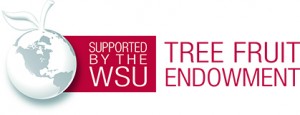Written by Tianna DuPont, WSU Extension. April 8, 2022
During bloom it is critical to consider your risk for fire blight infections. Temperature and moisture conditions dictate the risk of infection. Variety, tree age, block history and likelihood of dew determine the susceptibility of the block.
Seasonal Risk Factors
The majority of fire blight infections in Washington start as flower infections. Insects or wind-blown rain move fire blight cells oozing from overwintering cankers into flowers. When temperatures are warm pathogen cells introduced to flowers multiply quickly on nutrient rich floral stigma. Fire blight bacteria multiply very quickly between 70 and 80 F with moderate growth between 60 and 70 F and some growth above 50 F. If rain or heavy dew occurs bacterial colonies are washed down the style into the floral cup where they can invade the flowers through the nectaries. Erwinia amylovora can also infect susceptible young tissue directly through wounds (e.g. insect feeding, wind and hail) causing shoot blight infections.

Your seasonal fire blight risk is determined by the environmental conditions during bloom. Warm, wet conditions during bloom lead to high fire blight risk. For example, in 2018 three wet periods during bloom throughout Washington state coincided with warm conditions resulting in wide-spread infections. In contrast in a relatively cool, dry bloom period like 2021 fire blight risk and infection was much lower.
When environmental conditions are/ will be conducive to disease it is critical to manage the disease:
- If temperatures are warm during bloom fire blight risk is high. Manage if moisture occurs (from rain or dew). See example programs.
- Windy conditions or hail create wounds allowing fire blight to infect. Manage preventatively when possible or use a systemic antibiotic right after a wind/hail event.
In cool dry springs fire blight risk is lower. Consider the risk factors for your block. Management in cool dry springs may be unnecessary.
Use the Cougar Blight Model to assess risk. The Cougar Blight Model is available on the Decision Aid System. The Cougar Blight Model estimates the

risk of fire blight infection during bloom by calculating temperature risk values which consider hourly temperatures and Erwinia amylovora bacterial growth rates and predicts potential infection events based on blossom wetting.
In organic be proactive. In organic blocks or when streptomycin resistance is suspected it is critical to be proactive. Look at the Cougar Blight forecasts for upcoming disease pressure. Organic management must be preventative.
Risk Factors for the Block
Map out your high and moderate risk blocks. High risk blocks with young trees, susceptible varieties, a history of block or humid pockets should receive more aggressive management than moderate risk blocks.
Highest Risk
- Young trees
- Susceptible varieties
- Blocks with history of blight
- Humid areas
Low to moderate risk blocks
- Older trees
- Less susceptible varieties
- Low history of fire blight
Additional Information
WSU factsheet. Product efficacy reports are located at the bottom of the page!
Visit for the recent model projections of blossom blight risk at your site.
Crop Protection Guide recommendations are updated on an annual basis.
Organic Fire Blight Management in Western US
eOrganic article.
A description of the Cougar Blight Model for determining fire blight risk.
Plan for Multiple Fire Blight Conditions, Be Agile
Example programs for high and low risk blocks. WSU Newsletter article, Updated March 2022.
Fire blight cankers left in the orchard are the source for new spring infections. WSU Newsletter article, February 2022.
Fire Blight Susceptibility of Apple Cultivars
Written by: Sarah Kostick, WSU Horticultural Doctoral Candidate. May 2019.
References
Johnson, K.B., V.O. Stockwell, D.M. Burgett, D. Sugar, and J.E. Loper. 1993. Dispersal of Erwinia amylovora and Pseudomonas fluorescens by honey bees from hives to apple and pear blossoms. Phytopathology 83(5): 478-484. DOI: 10.1094/Phyto-83-478.
Ogawa, J., and H. English. 1991. Diseases of temperate zone tree fruit and nut crops. Publication 3345. University of California Division of Agriculture and Natural Resources. Oakland, California.
Pattemore, D.E., R.M. Goodwin, H.M. McBrydie, S.M. Hoyte, and J.L. Vanneste. 2014. Evidence of the role of honey bees (Apis mellifera) as vectors of the bacterial plant pathogen Pseudomonas syringae. Australasian Plant Pathology 43(5): 571-575.
Pusey, P.L., Curry, E.A., 2004. Temperature and pomaceous flower age related to colonization by Erwinia amylovora and antagonists.
Smith, T.J., Pusey, P.L., 2010. CougarBlight 2010 ver. 5.0, a Significant Update of the CougarBlight Fire Blight Infection Risk Mode. Acta Hort, 331-338.
Contacts
Tree Fruit Extension Specialist, WSU Tree Fruit Research and Extension Center
tianna.dupont@wsu.edu
(509) 713-5346 (cell)
(509) 293-8758
Fruit Matters articles may only be republished with prior author permission © Washington State University. Reprint articles with permission must include: Originally published by Washington State Tree Fruit Extension Fruit Matters at treefruit.wsu.edu and a link to the original article.

